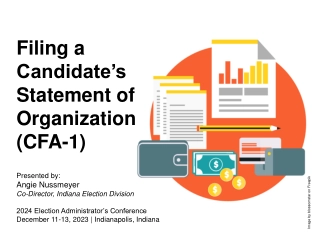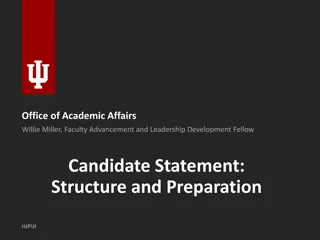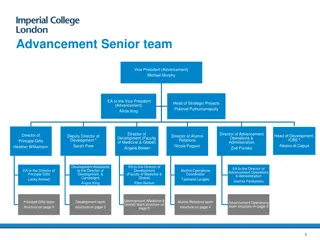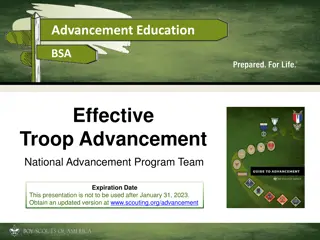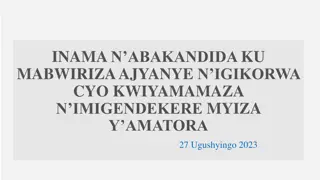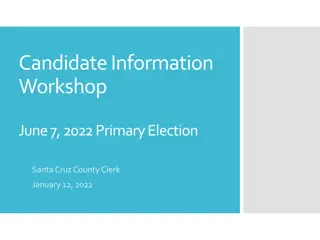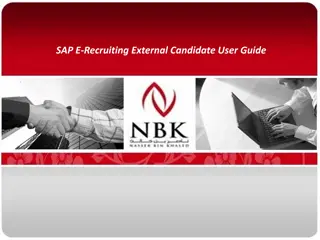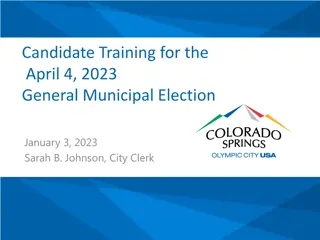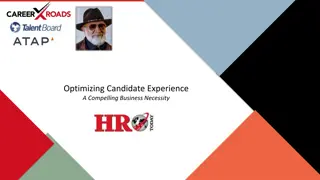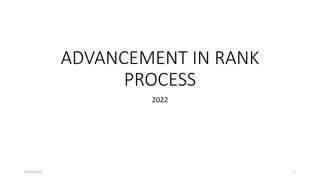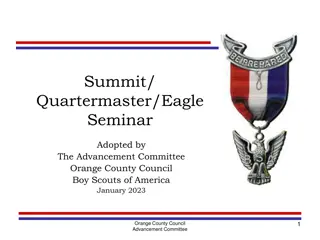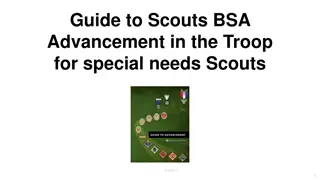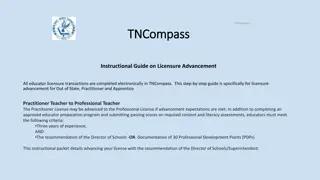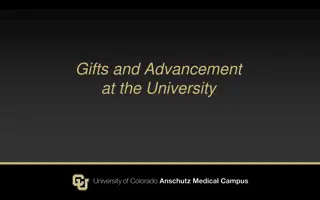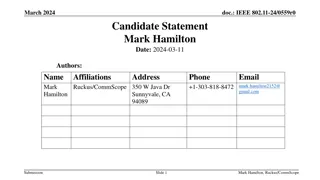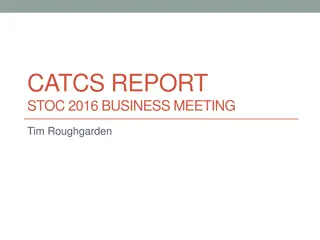Building a Strong Candidate Statement for Academic Advancement
Guidelines and steps for structuring and preparing a compelling candidate statement for academic advancement, including key questions, outlining, writing strategies, and leveraging AI tools effectively. Special emphasis on themes, evidence, and overall excellence in presenting accomplishments.
Download Presentation

Please find below an Image/Link to download the presentation.
The content on the website is provided AS IS for your information and personal use only. It may not be sold, licensed, or shared on other websites without obtaining consent from the author.If you encounter any issues during the download, it is possible that the publisher has removed the file from their server.
You are allowed to download the files provided on this website for personal or commercial use, subject to the condition that they are used lawfully. All files are the property of their respective owners.
The content on the website is provided AS IS for your information and personal use only. It may not be sold, licensed, or shared on other websites without obtaining consent from the author.
E N D
Presentation Transcript
Office of Academic Affairs Willie Miller, Faculty Advancement and Leadership Development Fellow Candidate Statement: Structure and Preparation IUPUI
Special thanks to Rachel Applegate, Assistant Vice Chancellor for Faculty Affairs
Agenda Part I: Key steps Part II: Structure of a Candidate Statement Part III: Special areas of emphasis Part IV: Style notes IUPUI
Key Steps 1. Step 1: Questions to ask yourself to begin with 2. Step 2 Writing a) Outline (main sections) b) Just write (your life themes) c) Get AI to help 3. Step 3: Review (get others to help) 4. Step 4: Completeness 5. Step 5: Polish IUPUI
Step 1: Questions to ask yourself to begin with 1. Why do I do what I do? 2. How do I do what I do? 3. What are some concrete things I can point to that show what I do? What are my signature accomplishments? 4. Can I group my CV into themes? (not necessarily ALL of it.) How do I explain myself to non-academics? How do I introduce myself at conferences? What motivates me? How is this reflected in the items on my CV? IUPUI
Step 2: Writing Step 2a: Design an Outline 1. Use Candidate Statement Template 2. Adjust for your: Faculty type (tenure track, clinical, lecturer, research, librarian) Rank sought (associate, full; senior/teaching professor) 3. Within your main area of excellence, identify: Key themes Pieces of evidence (CV entries and other documentation) 4. Summarize: You have met the overall criteria You have a future IUPUI
Step 2: Writing Step 2b: Just Write 1. I am . 2. I do this . 3. Because I . 4. Now that you know (I have told you) Z, X, and Y, you will agree I meet the criteria IUPUI
Step 2: Writing Step 2c: Get AI to help There are many AI-enabled tools that can help you to consider how you might present your work. 1. Ask an AI tool like Chat GPT: Write a candidate statement for someone in your field going for promotion to your next rank. 2. Review how the tool framed a case and consider how you may emulate elements of that framing for your own statement. Important Note: An AI tool does not know the specifics of your career or the dept/school/campus criteria. As a result, an completely AI-generated candidate statement will not be sufficient for your dossier. IUPUI
Step 2: Writing Wow, this is too short Add details, descriptions, and for examples. Include not just the what but the why What led up to your signature accomplishments? Wow, this is too long See where you can condense into summary sentences Remove examples [move to the rest of the dossier] Keep the focus on signature accomplishments Make the future plans part coherent with the past accomplishments IUPUI
Get to at least this step before coming to the hands-on workshop Step 3: Review 1. What do you have? Don t worry if it is too long or too short. During Step 4, you will adjust for length. 2. What sense does it make? Are there themes? How do the themes relate to each other? Is there a balance between representing how much work you have done (lots of stuff) and focusing on signature accomplishments? What is the importance of what you have done? 3. What does someone else make of it? At this point, it s useful to have someone outside of your discipline read it. You want something that is understandable to outsiders. Later you can have someone in the discipline examine it for technical correctness. IUPUI
Tip: lift.iupui.edu Consider a LIFT Mentoring Circle
Step 4: Completeness 1. Check the checklists in P&T Guidelines, in Candidate Statement Template 2. Go through dept, school, campus criteria: do you explicitly name/claim them? 3. Highlight where you have mentioned key elements for substantiation: student/peer input for teaching, forms of dissemination for research, scholarly and non-scholarly impact. How do these support your areas of excellence and themes? Does the organizational framework still make sense? Is one theme too weak? 4. What are your readers saying? Does someone in your department/discipline think it is compelling? Strong science, teaching, service? IUPUI
Step 5: Polish 1. Is the final product smooth and coherent? Read it aloud for editing errors (where one section gets moved and some wording ends up wrong) Highlights easily seen Check acronyms or technical language; explain/expand at least once 2. Check details against the CV: are all references and summaries consistent? Did you number your citations? (or hyperlink?) Are you counting #s of articles, presentations, grants? 3. Check against rest of dossier: are you ready to supply details and substantiation? Typos are potholes: they aren t usually damaging but they interrupt the flow 4. Proofread; ask someone else to proofread. IUPUI
to 1 page Part II: Structure of a Candidate Statement 3-4 pages 1. Introduction Who you are What you are applying for 2. Area of excellence Main focus and themes; philosophy if applicable Signature items Impact Comparison to criteria Future plans 3. Satisfactory area/s Evidence of solid performance 4. Summary: distinctive impact 5. Future plans 1 page 1 page IUPUI
Part III: Special areas of emphasis 1. Area of excellence 2. Signature items Work in rank Reputation, trajectory, impact 3. Independence IUPUI
Area of excellence Third Year Review Should be settled by the end of the third (or fourth) year review Final Review Must be definite Cannot be chosen or determined by anybody OTHER THAN the candidate If you are uncertain, draft multiple statements, with different areas Must be clear to the reader About 2/3rds of final product will be about this area Integrative DEI case: holistic, not separated Balanced-Binned: use equal space for each area IUPUI
Signature items Third Year Review Have at least one since starting at IUPUI Final Review Three to five specific items Multiple articles can be threaded together to lead up to key items Others may be projects you are currently working on All of those specific items must be in- rank. Most should be work completed at IUPUI Previous work can be mentioned as leading up to the signature items IUPUI
Signature items, trajectory, reputation Signature items must have been accomplished in rank. They may not have had much time to attract formal scholarly citations. Your reputation may be best demonstrated and documented by: Work prior to rank this has had time to acquire citations and other uses. When you use work from earlier in your career, describe how it created a foundation for current work. Media/non-scholarly uses of the work Invitations to speak on your work IUPUI
Independence Write in the first person singular. For multiple-author and multiple-investigator projects, be clear about what your role is. What did you uniquely contribute to those projects? From P&T Guidelines: Candidates should make clear to readers their independence and the impact of their work. Candidates engaged in interdisciplinary work or team science should make every effort to represent their contribution to collaborative scholarship clearly, as well as the significance and value of any interdisciplinary approach they are pursuing. Candidates should carefully document their individual contributions within this context and should also demonstrate some level of independent research beyond the team science work. Candidates should be careful to provide clear and sufficient information about their individual roles in collaborative projects, publications, presentation, or grants. IUPUI
Where to document independence 1. Sometimes: in the CV, make small notes about your role. 2. In the candidate statement: describe your role in terms of your own career and accomplishments. 3. In the dossier, in the Research folder, Discussion of 3-5 items , describe role in relation to each project / stream of accomplishments. 4. In the appendix, include confirmation from co-authors. At least one co- author, from at least the signature items. Best practice: get documentation as you go, for everything. IUPUI
Part IV: Style Notes 1. Clarifying rank sought 2. Examples Who I am My research Addressing criteria Clarification of details Discipline-specific metrics IUPUI
Who I am To engage in social justice, community-engaged work means aligning my values and actions. To walk the talk as a scholar means to be who I am authentically while calling out inequities, particularly involving those who have been historically marginalized. Cristina Santamaria Graff pt Balanced My background provides context for my technology-focused in-rank research activities. While working as a clinical social worker in the field of mental health, several transformative experiences I became discouraged with the pervasive practice of separately targeting signs and symptoms for management with multiple medications . David Wilkerson pt Research IUPUI
Ayoung Yoon, LIS/INFO, research area of excellence Examples Defining terms Over the past decade, my research has focused on data curation, which is the long-term management of data to ensure optimum use and reuse throughout its lifecycle. Data is crucial to historical or longitudinal inquiry My main focus is on the behaviors of persons who reuse data . Why it is important What my particular contribution is IUPUI
Side-bar: just the science? Culturally responsive teaching [and mentoring] recognizes, affirms, and values students cultures and their unique experiences. The greatest single motivator for these [diverse STEM doctoral students] was a desire to help others. Ebony Omotola McGee, Black, Brown, Bruised It is appropriate to talk about who YOU are and WHY you do what you do. IUPUI
Addressing criteria I have achieved excellence in support of teaching and learning by building two learning communities that train other faculty. Additionally, I have achieved what the IUPUI Promotion and Tenure Guidelines refer to as curricular development excellence by disseminating my ideas on learning communities through nine peer-reviewed conference presentations. Nancy Goldfarb, teaching professor In each section, According to the SOE criteria . Cristina Santamaria Graff IUPUI
Clarification of details At IUPUI a themed learning community (TLC) consists of two general education courses and a first-year seminar integrated by a common theme. Nancy Goldfarb, teaching professor Family caregiving is accompanied by significant [Wilkerson] Family as faculty from Santamaria Graff IUPUI
Discipline-specific metrics [Fellowship training program director] Over the past seven years we have ensured no citations were listed for the vascular surgery program. Raghu Motaganahalli, full clinical I care about student success .I closely monitor DFW rates and seek ways to reduce them. Below is a chart showing DFW rate drops for courses taught or mentored exclusively by me. Lingma Lu teaching professor I take satisfaction that all the graduating fellows that I trained have found positions in well-known private and academic practices throughout the country. Juan Tejada, associate clinical Because of my contributions to the field, I was recently invited to the March 2020 invitation only Workshop on Knowledge Infrastructure a broad, interdisciplinary discussion. Ayoung Yoon, pt research IUPUI
A template, an example Template Example (entirely fake) Annotated example (still fake) Samples (real!) IUPUI
Thank you! Willie Miller wmmiller@iupui.edu Rachel Applegate rapplega@iupui.edu


